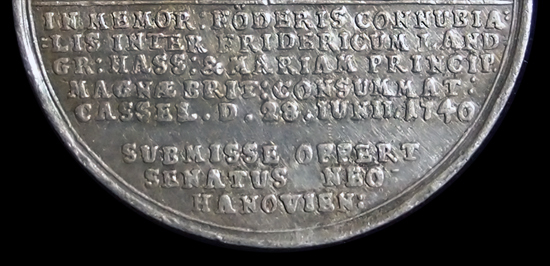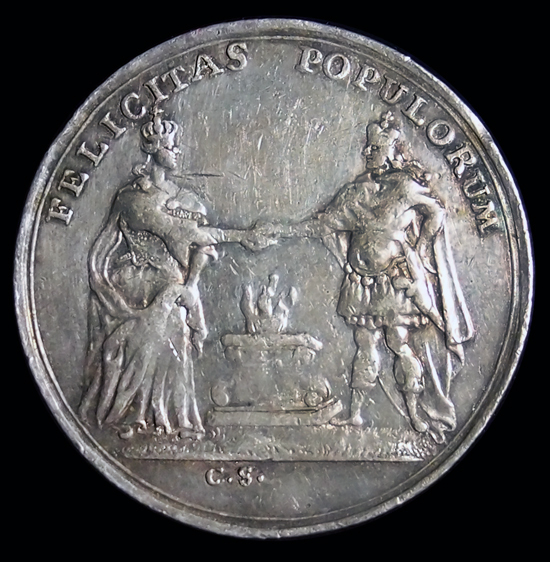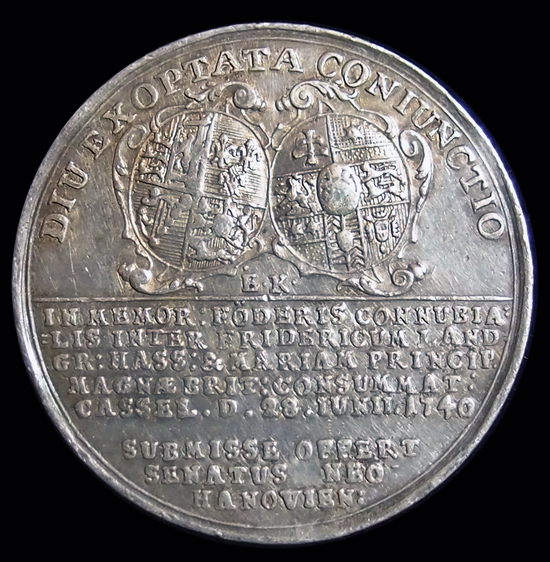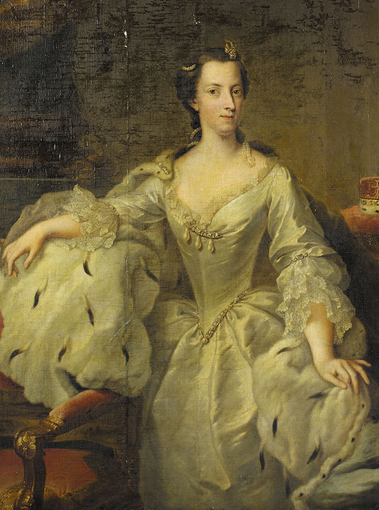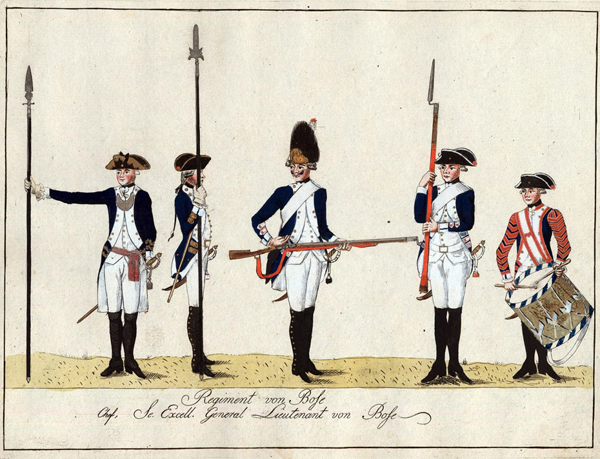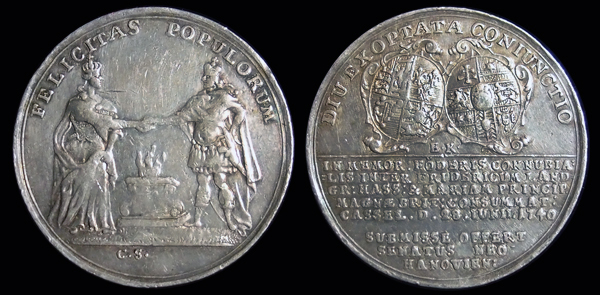
SILVER MEDAL COMMEMORATIVE: MARRIAGE OF PRINCESS MARY OF GREAT BRITAIN TO FRIEDRICH II OF HESSEN-KASSEL
Obv: The couple join hands over a flaming altar / FELICITAS POPULORUM - C.S.
Rev: Linked shields of arms, legend around / DIU EXOPATA CONIUNCTIO, and 8 lines of text below - EK
CHRISTIAN SCHIRMER and JOHAN ENGELHARD KRULL
Depicted on the obverse of this medal is Princess Mary of Great Britain, daughter of King George II of the House of Hanover and Friedrich II, Landgraf of Hessen-Kassel of the House of Hesse. The two are standing facing each other with joined hands over a burning alter. Around the top reads FELICITAS POPULORUM (The Happiness of the People.) Below are the initials C.S. which stand for Christian Schirmer who was warden at Königsberg Prussia and mint master from 1742-1743. The reverse of the medal depicts the coat of arms of the two royal houses, Great Britain on the left and Hessen-Kassel on the right. Around the top reads DIU EXOPTATA CONIUNCTIO (Long Desired Union.) Below reads IN MEMOR: FODERIS CONNUBIA: LIS INTER FRIDERICUM LANDGR: HASS & MARIAM PRINCIP. MAGNAE BRIT: CONSUMMAT: CASSEL. D. 28. IUNII. 1740 - SUBMISSE OPPERT SENATUS NEO HANOVIEN (In Memorial: Marriage of Alliance between Frederick Landgraf of Hasse and Mary of Great Briton, Consummated in Kassel on June 28, 1740 - humbly presented by the senate of Neu-Hanau.) below and between the coat of arms are the initials E.K. which stands for Johann Engelhard Krull who was Mint-Master at Hanau, Kassel, and Frankfurt from 1737 to 1742 and Brunswick from 1742 to 1750.
Mary was the sixth of the seven surviving children of King George II of Great Britain (of the House of Hanover) and his wife Caroline of Brandenburg-Ansbach (of the House of Hohenzollern) and the fourth of their five daughters. Friedrich was the second of three children born to Wilhelm VIII, the Landgrave of Hessen-Kassel (of the House of Hessen-Kassel) and his wife Dorothea Wilhelmina of Saxe-Zeitz (of the House of Wettin) and the only son to survive infancy. Dorothea Wilhelmina became mentally ill and no longer appeared in public after 1725. This was more an alliance between two royal houses than a marriage between two individuals. The couple never met each other before they were married. The marriage was negotiated by officials of state, which was not uncommon in marriages between royalty, and the Parliament of Great Britain voted to endow Mary with 40,000 pounds for the marriage. The couple was married first by proxy at St. Jame's Palace in London on May 8 1740 with Mary's brother standing in for Friedrich, and then she traveled to Kassel to meet her new husband and they were wed on June 28 of that same year. Friedrich traveled to Scotland at the head of 6,000 Hessian troops to aid his father-in-law George II during the Jacobite rising of 1745. Between 1740 and 1747 Friedrich and Mary had four sons. His first son prince Wilhelm died in infancy and his second son and successor, who was also named Wilhelm, would become Wilhelm IX, Landgraf of Hessen-Kassel and was later created Prince-Elector of the Holy Roman Empire as Wilhelm I. His other two surviving sons were Prince Karl who had a long career in the military, was Governor General of Norway, Governor of Schleswig and Holstein, and served as commander-in-chief of the Norwegian army, and Prince Friedrich also served in the military in the Danish Auxiliary Corps against Napoleonic France. Although their marriage was fruitful and gave Friedrich three sons, it was not a happy one. Friedrich was said to be cruel and abusive and after the birth of his forth son in 1747 they began living apart from each other with Mary making an extended trip to Britain for a time. Although his family and the people of Hessen-Kassel were largely Calvinist, he converted to Catholicism while visiting the Archbishop-Elector of Cologne, Clemens August of Bavaria in 1749. Hessen-Kassel being largely Protestant as was his father, his father-in-law and all of his family, his decision to convert to the catholic faith was not a popular one.
By all accounts the marriage was virtually ended and the couple no longer lived together or saw each other again. After his conversion to Catholicism and their separation, the couple was formally separated, with the blessing of Friedrich's father who provided her with a residence in Hanau, in 1754. In the following year, not wanting to move back to Great Britain, Mary moved to Denmark where her sister Louise was Queen. Her sister was the wife of Frederik V King of Denmark and Norway before her untimely death in 1751 at the age of 27 of complications from a miscarriage. Mary would remain in Denmark where she and her sons became a part of the royal court in Copenhagen. After being formally separated from his wife, Friedrich entered active service in the Prussian military. Before is death, Friedrich's father sought to ensure that Friedrich could not attempt to change the religious confession of his lands. To this end he made Hanau-Münzenberg a secundogeniture of Hessen-Kassel known as Hessen-Hanau, and transfered it to his grandson, Wilhelm, Friedrich's son and successor who was still a minor. When his grandfather died Wilhelm was put under the guardianship of Mary as regent until he came of age and Friedrich was excluded from any direct involvement. Hesse-Hanau was governed by Princess Mary from 1760 to 1764 and afterward by her son William IX until it was reunited with Hesse-Kassel upon the death of Friedrich.
Upon his fathers death in 1760, Friedrich succeeded him as Landgraf of Hessen-Kassel. Despite his fathers fears, Friedrich's subjects remained Calvinist and Friedrich's own children were raised as Protestants in the courts of Denmark having no contact with their father. As there had been no divorce, Mary was then Landgravine of Hessen-Kassel as well as regent for her son. Friedrich never saw his wife again and did not see his children until 1782, just a few years before his death. Friedrich is well known as the man who provided George III (his nephew-in-law) the lions share (16,992) of leased auxiliary troops to fight under the command of the British in the American Revolution. Hessen-Kassel was Europe's most militarized state. Its military was based on the Prussian model and it's soldiers were very well trained veterans of many conflicts. These troops were commanded of behalf of Britain by Wilhelm Reichsfreiherr von Innhausen und Knyphausen, a Prussian who served in the army of Hessen-Kessel. Hessian troops under Knyphausen's command fought in the Battles of White Plains, Fort Washington, Brandywine, Germantown, Springfield, and Monmouth.
Because a large percentage of German troops fighting for the British were from Hessen-Kessel or Hessen-Hanau all the German auxiliary troops in British service were often called Hessens, however troops were also sent from Brunswick, Ansbach-Bayreuth, Anhalt-Zerbst and Waldeck. Friedrich earned significant revenue by leasing soldiers, not only to Great Britain but other European monarchs in need of extra manpower. He used this money to fund his patronage of the arts and sciences, an opulent lifestyle, and building projects such as modernizing his capitol of Kassel with the help of the architect Simon Louis du Ry. Mary passed away on January, 14 1772 at the age of 48 and Friedrich was free to marry again. On January 10, 1773 he married Margravine Philippine Auguste Amalie of Brandenburg-Schwedt in Berlin. Although no Children were born of this union Philippine was instrumental in reconciling him with his sons. On October 31, 1785, Friedrich II, Landgrave of Hessen-Kassel died suddenly from a stroke at the age of 65 at Castle Wessenstein in Kassel. He was succeeded by his son who ruled as Wilhelm IX, later Wilhelm I when he was made Prince Elector. Friedrich left his son a developed and healthy economy, as well as a full treasury, when he died and with his death Hessen-Kassel was reunited with Hessen-Hanau under Wilhelm. Friedrich was buried at the Roman Catholic Church of St. Elisabeth in Kassel which was built on Friedrich's order by architect Simon Louis du Ry between 1770 and 1777. He is the only Landgrave of Hessen-Kassel who was not buried in the Protestant Martinskirche (St. Martin's Church) in Kassel. |

